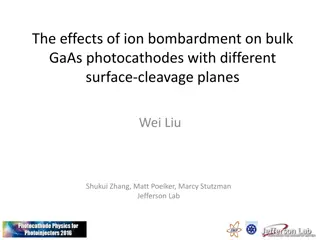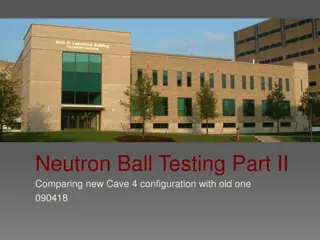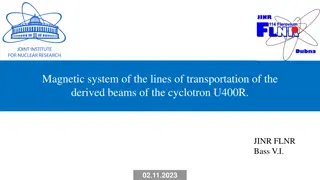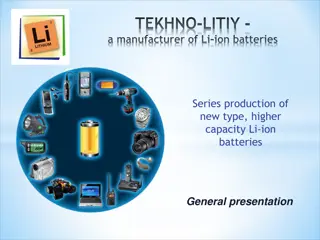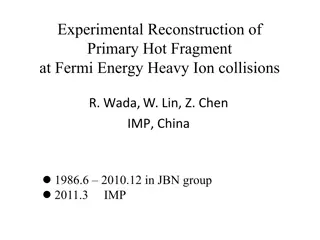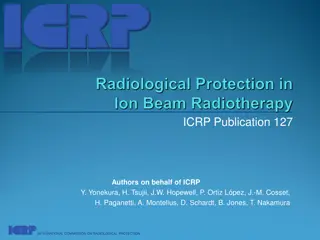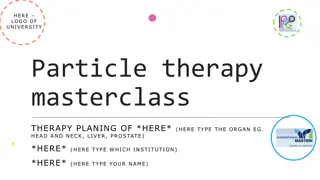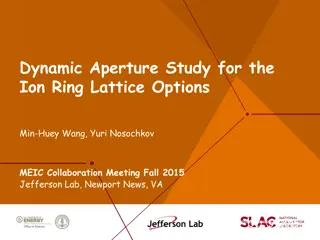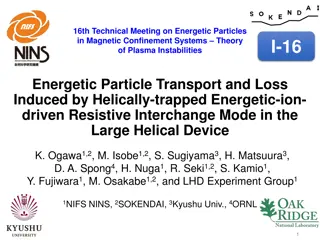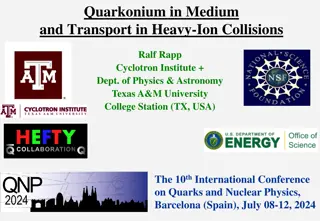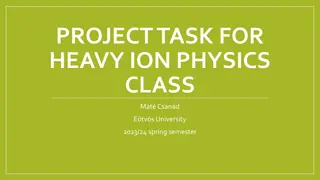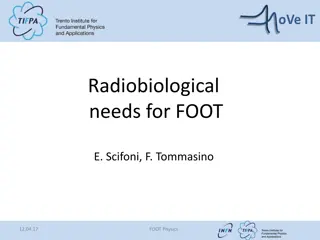Advancing Cyclotron Technology with Internal RF H-Ion Source
Explore the innovative Internal RF H-Ion Source for Cyclotrons funded by Horizon 2020. Revolutionize cyclotron technology with efficient ion production. Enhance beam quality and stability for advanced applications in research and industry.
Download Presentation

Please find below an Image/Link to download the presentation.
The content on the website is provided AS IS for your information and personal use only. It may not be sold, licensed, or shared on other websites without obtaining consent from the author. Download presentation by click this link. If you encounter any issues during the download, it is possible that the publisher has removed the file from their server.
E N D
Presentation Transcript
This project has received funding from the European Unions Horizon 2020 Research and Innovation programme under GA No 101004730. Internal RF H-Ion Source for Cyclotrons. Task 12.3 19-04-2023 / I.FAST 2ndAnnual Meeting Daniel Gavela (Ciemat) on behalf of RF ion source developing team: - Tomas Eriksson (GE) - Pedro Calvo, Antonio Est vez, Luis Garc a-Tabar s, Daniel Gavela, Miguel Le n, Diego Obradors, Concepci n Oliver, J.M. P rez, Fernando Toral (Ciemat)
IFAST Task 12.3. Internal Ion Source for Cyclotrons. Concept Magnetic field A new concept of internal ion source based on RF for cyclotrons: Change DC voltage of conventional Penning ion source to a RF voltage Expected advantages of RF ion source versus Penning: Lower cathode wear (sputtering). Less maintenance time, irradiation and cost. Cathode is heated by RF currents, no need for ions impact. Lower electron energies (~ 10 eV) -> better efficiency of producing H-, leading to reduction of H2flow needed and better vacuum in the cyclotron. No high voltage Cathodes Anode Extraction V Plasma CONVENTIONAL PENNING ION SOURCE Magnetic field Electrode Electrodes 1 Extraction ~ RF power Plasma RF quarter wave cavity PROPOSED RF ION SOURCE Daniel Gavela Internal RF Ion Source For Cyclotrons I.FAST 2ndAnnual Meeting April 2023 2
IFAST Task 12.3. Internal Ion Source for Cyclotrons. Concept Innovative concept Potential commercial application, mostly oriented to medical cyclotrons Simple concept, with relatively easy implementation on existing commercial products Partnership industry (General Electric, Cyclomed) labs (Ciemat) I.FAST Task 12.3 objective: Design & manufacture a first demonstrator prototype Perform its experimental characterization (plasma production and beam extracted) Daniel Gavela Internal RF Ion Source For Cyclotrons I.FAST 2ndAnnual Meeting April 2023 3
IFAST Task 12.3. Internal Ion Source for Cyclotrons. Progress Task progress from may 2021 to apr 2023 Definition of specifications for the ion source prototype Calculations and simulations to arrive at a conceptual design Development of a detailed mechanical design Welding tests Fabrication of all ion source components and toolings Bending of the cooling and hydrogen tubes for the ion source Brazing of the ion source Low power RF tests Daniel Gavela Internal RF Ion Source For Cyclotrons I.FAST 2ndAnnual Meeting April 2023 4
IFAST Task 12.3. Internal Ion Source for Cyclotrons. Fabrication FABRICATION FINISHED About 6 months later than expected. We asked for an extension of the milestone and deliverable. Reasons for the delay: Long deliverable terms of materials and manufacturing companies Change in brazing procedure: from manual brazing with torch to vacuum brazing -> redesign of toolings One tube not brazed > change shape of tube and repeat brazing Tube fell down in brazing Daniel Gavela Internal RF Ion Source For Cyclotrons I.FAST 2ndAnnual Meeting April 2023 5
IFAST Task 12.3. Internal Ion Source for Cyclotrons. Low power RF tests One port measurement, fixed frequency (no tuning) Quality factors close to expected (not negligible losses are at the RF connections, outside the cavity). Good enough to achieve reasonable overall loss. Good couplig (close to critical) difficult to achieve, but good enough Cu electrode Cu electrode Small coupler = 0,38 Q0= 575 fres = 2,428 GHz Ta electrode Big coupler = 0,34 Q0= 195 fres = 2,398 GHz Cu electrode Big coupler = 1,44 Q0= 591 fres = 2,324 GHz Ta electrode Daniel Gavela Internal RF Ion Source For Cyclotrons I.FAST 2ndAnnual Meeting April 2023 6
IFAST Task 12.3. Internal Ion Source for Cyclotrons. Experimental phase To be performed in second half of 2023 1stphase: plasma ignition and characterization using light spectroscopy Using an instrumented chimney New IST (ion sources test) facility in Ciemat: 0,8 Tesla dipole RF vacuum cavity for extraction (60 MHz, 10 kV) 2ndphase: measuring and characterization of the beam extracted Using the normal (with extracting slit) chimney LLRF system for ion source and extraction Auxiliary systems (cooling, hydrogen, ) Diagnostics systems: Visible range spectrometer and fiber optic line for plasma study Beam prove with micro-amperimeter for beam current measurement Daniel Gavela Internal RF Ion Source For Cyclotrons I.FAST 2ndAnnual Meeting April 2023 7
Thanks This project has received funding from the European Union s Horizon 2020 Research and Innovation programme under GA No 101004730.



